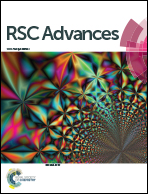A sol-hydrothermal route to truncated tetragonal bipyramid nanocrystals and hierarchical hollow microspheres of anatase TiO2 for application in dye-sensitized solar cells†
Abstract
In this work, a series of nano- and microcrystals of anatase TiO2 including well-defined truncated tetragonal bipyramids (TTBs) (15–20 nm) and hierarchical hollow microspheres (HHMs) (1.5 μm) were successfully synthesized using a facile sol-hydrothermal approach free from surfactants and templates. The latter HHMs also consisted of similar TTBs but bigger in size. The conversion pathway to TiO2 mainly depended on the volume ratio of H2O2 to NH3. In the presence of NH4F, small TTBs were generated as a result of inhibited growth along both [100] and [001] directions. The formation of HHMs through gradual depletion of the yolk followed a typical Ostwald ripening process. Their photovoltaic activities were investigated on dye-sensitized solar cells (DSSCs) using bilayer photoanodes made of typical TTBs and HHMs. The cells delivered a power conversion efficiency (PCE) of 9.06%, corresponding to a 51.5% increment over those fabricated in the same way using P25 and 400 nm TiO2 (CCIC). Meanwhile, the short-circuit current density (JSC) reached up to 18.38 mA cm−2, which was 1.46 times that of the P25 + CCIC cells. They were also superior to previously reported DSSCs based on highly crystalline nanooctahedra and agglutinated mesoporous microspheres. The small particle size of TTBs and micrometer size and hierarchical structure of HHMs endowed the bilayer photoanodes with a synergetic effect of dye loading and light scattering. Moreover, their exposed {001} and {101} facets, which could facilitate spontaneous charge separation through preferential carrier flow towards specific facets, and highly crystalline anatase phase rendered the cells efficient in charge collection.



 Please wait while we load your content...
Please wait while we load your content...